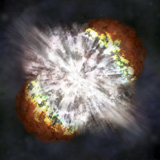Researchers at the University of California, Irvine have discovered evidence of a supernova that occurred in the early universe, almost twice as old as the oldest known supernova.

Researchers at the University of California, Irvine have discovered evidence of a supernova that occurred in the early universe, almost twice as old as the oldest known supernova.

10 תגובות
Roughly, closer to 5 billion because it still takes time for the dust cloud that surrounds the sun to collapse and the clumps that are formed to collapse further into each other until planets are formed
Thanks. 4.6 This is also the age of the solar system, right?
Amit, the age of the earth is 4.6 billion years. The estimated age of the universe today is about 13.7 billion years.
I did not understand,
After all, it is known that the age of the universe is 4.6 billion years, how are there events from 6 and 11 billion years ago?
Thanks.
That's right, my father
And the proof of this is Elvis Presley and Michael Jackson. Big stars that faded fast.
The bigger the star, the shorter the debtor's duration. Giant stars live only millions of years or less.
A.P.
Not necessarily.
Here and there - even if not in large quantities, stars could have formed immediately with the formation of the universe.
There is even a hypothesis that talks about primordial black holes (which is even bigger than a star) (that is, created already in the big bang)
Doesn't this raise questions about the age of the universe again? In light of the models regarding the time it took until massive stars began to form after the big bang, and until such a star reaches the stage of collapse. After all, the explosion happened already 11 billion years ago.
11 billion light years, wow! It's hard to even understand how far it is